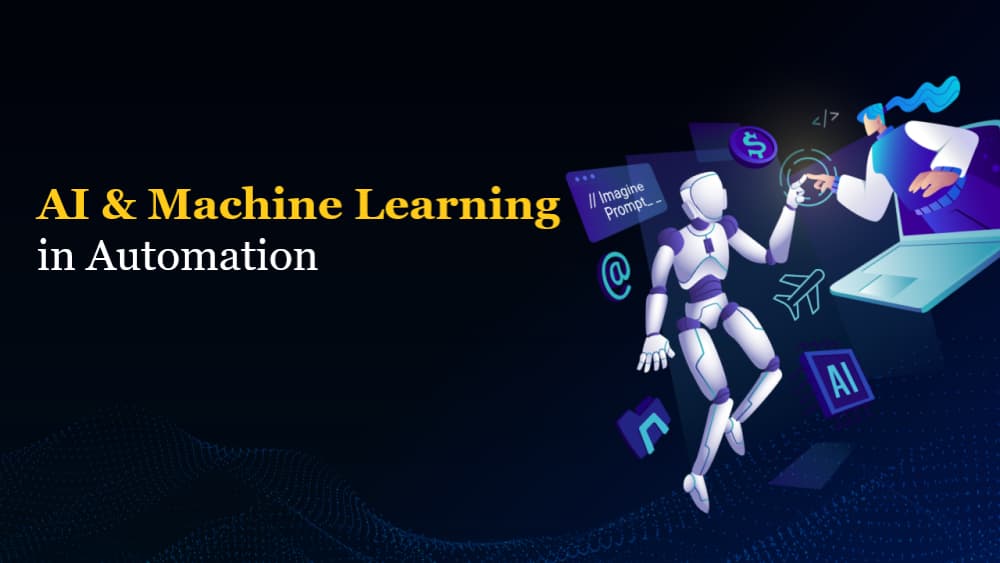The Automation Advantage: Why AI and ML Services Are a Must-Have in 2025

AI and ML services redefine the way companies do business and compete in the current digital age. The technologies have experienced significant growth over the past few years. This reflects a basic shift in what businesses value. Companies that fail to embrace these cutting-edge solutions risk being left behind as digital transformation increases momentum.
About 92% of companies are expected to increase their AI investments in the next three years. These numbers depict why finding the right AI ML development partner is vital to green practices and growth. The global AI market is projected to grow from $184 billion in 2024 to $826.70 billion by 2030. This creates new opportunities for businesses that work with an AI ML company.
This piece explains why AI and ML development services are crucial for businesses in 2025. It covers building adaptable AI strategies and how AI agents impact workforce changes.
Why AI and ML Are Strategic Imperatives in 2025
In 2025, businesses see AI & machine learning services as important innovation drivers, not just technological tools. Data volumes have grown exponentially. Organizations that can harness and govern this information effectively can create new opportunities for growth.
AI As a Driver of Business Transformation
AI and ML services help companies achieve measurable business outcomes. These technologies boost customer satisfaction, provide unique digital services, enhance operations, and cut costs.
The effects are remarkable across multiple sectors. AI in healthcare enhances clinical efficiency and sharpens diagnostic accuracy. Telecom companies learn about customer behavior and improve network performance. Banks and financial institutions utilize these technologies to personalize services, analyze risks, and detect fraud.
The Shift from Experimentation to Enterprise-Wide Adoption
Companies are moving from small AI experiments to complete organization-wide implementation. Research indicates only 11% of organizations describe their AI use as “transformational”. This number will more than double to 27% soon.
Google Cloud’s vice-president, Moe Abdula, notes a “drastic difference” in the AI landscape over the last year. Customer discussions now focus on business value and return on investment rather than experimentation.
Why AI ML Services are No Longer Optional
Working with an AI ML development company has become crucial for several reasons:
- Competitive edge: Businesses using AI and ML can become leaders by providing intelligent products and services.
- Data management need: Global data creation will hit 181 zettabytes in 2025
- Transformation of workflows: 21% of companies redesigned their workflows with generative AI.
- Financial necessity: Worldwide spending on AI will increase to $632 billion by 2028.
Building a Scalable AI Strategy: From Ground Game to Moonshots
A balanced portfolio approach helps organizations create value at scale through their AI strategy. Companies that get the best returns from AI & machine learning services use a three-tiered approach. This method balances quick wins with long-term changes.
Ground Game: Small Wins with Big Effect
Success in AI strategy starts with small, focused projects that bring quick wins. These projects target specific business challenges and show results within 6-12 months. Research shows that companies with the highest AI returns focus 62% of AI value on core business processes instead of experimental cases.
Small ground-game projects often start with task automation or workflow improvements. Each success builds team confidence and expertise. This creates momentum and unlocks resources to support larger, more transformative AI projects.
Roofshots: Mid-Level Innovation Projects
The next level up from ground game projects are “roofshots”—achievable yet ambitious AI projects that need dedicated resources. These mid-tier breakthroughs usually introduce new ways to work, connect with customers, or design products.
Executives must oversee roofshots through cross-functional teamwork. These projects bridge the gap between quick wins and bigger changes, letting organizations test their capabilities before making larger investments.
Moonshots: Transformative AI Business Models
Moonshot projects sit at the top tier. They are high-reward, challenging projects that can create new AI-driven business models. These bold endeavors might reshape entire business processes or lead to revolutionary products.
Moonshots should make up just a small part of your AI portfolio. Only 15% of Fortune Global 500 companies go beyond basic improvements to pursue transformative projects.
Choosing the Right AI ML Development Company
The right AI ML company plays a vital role in making the balanced portfolio approach work. Your chosen partner should:
- Offer technical expertise in algorithms and data handling
- Know how to scale with your business needs
- Match your business goals and deployment priorities
A reliable AI ML development company creates solutions that evolve over time. This helps organizations get quick results while staying ahead of competitors.
How AI Agents are Redefining the Workplace of Tomorrow
AI agents are becoming digital teammates in today’s workplace. This has led to significant changes in how organizations boost productivity, creativity, and solve problems.
Understanding AI Agents and Their Working
AI agents function as autonomous software programs that interact with their environment, gather data, and complete self-determined tasks based on preset goals. These systems are more sophisticated than basic chatbots.
AI agents tap into external data sources, maintain memory, and improve over time. The systems process specific instructions, plan tasks, access information, and implement solutions step by step. They get better by assessing outcomes, seeking feedback, and reviewing logs for future improvements.
Blending Human and Digital Workforces
The most effective approach combines human and digital workers in organizations. This teamwork removes repetitive tasks from human workers, letting them focus on creative and interactive work. Modern workplaces don’t aim to replace humans with machines. They create an environment where both complement each other’s strengths.
New Roles and Skills in an AI-Powered Workplace
AI is creating fresh job categories:
- AI trainers that help systems learn from company data
- AI assessors that review the latest models
- AI/human evaluation specialists that determine optimal collaboration points
- AI integrators that connect technical knowledge to business needs
Future employees require technical skills as well as human capabilities. Skills like critical thinking, adaptability, data literacy, and creativity become more valuable as AI handles routine tasks. Approximately 73% of organizations today view AI as a critical area of investment for staff development.
Governance, Trust, and Responsible AI in 2025
AI tools are spreading faster than most companies can manage. Most organizations struggle to set up the right controls for these powerful technologies. Business risks are piling up and need quick action because workplace AI usage has outgrown existing oversight capabilities.
Why AI Governance Is Now a Business Priority
AI governance needs immediate attention. 44% of U.S. workers are using AI tools without proper authorization. Employee behavior creates major security risks. Numbers show that 46% of U.S. workers upload sensitive company data to public AI platforms.
Gartner has named AI governance a key strategic trend for 2025. This shows how AI has moved from testing phases to full company-wide use. Companies now understand that poor governance leads to unwanted bias, hidden processes, and possible fines that hurt their profits.
Managing Risk and Ensuring Compliance
- Risk management must include:
- Clear AI usage policies and ethical guidelines
- Comprehensive data protection measures
- Regular bias and fairness audits
- Continuous monitoring of AI systems
The Role of Third-Party Audits and Benchmarks
AI ML companies need independent verification to build trust. The proposed Validation and Evaluation for Trustworthy (VET) AI Act creates ways for external evaluators to check if AI development meets safety standards.
These checks help companies spot hidden risks early. They prevent mistakes that can get expensive and show compliance with new rules like the EU AI Act, which can fine violators up to €35 million.
Conclusion
AI and ML services have moved from being selective add-ons to must-have business solutions. Companies must move faster to keep pace with competitors already using these technologies. Businesses that embrace AI experience improved customer satisfaction, streamlined operations, and reduced expenses.
Businesses need a balanced approach to AI implementation. They must begin with small, focused projects and transition towards more comprehensive goals. Such a portfolio strategy is commonly followed by successful companies. They address grassroots projects first, followed by mid-level accomplishments, and undertake transformational projects when they are prepared.
The modern workplace is undergoing a transformation as AI agents become digital teammates that work alongside humans. This partnership creates powerful results where machines handle routine tasks while people focus on creative and strategic work. The transformation introduces new job roles that need both technical knowledge and human skills like critical thinking and ethical judgment.
Effective governance is vital as AI adoption grows faster. Organizations must build resilient oversight frameworks to ensure accountability. Third-party audits help improve stakeholder trust, and ethical considerations help align technology use with corporate values.



